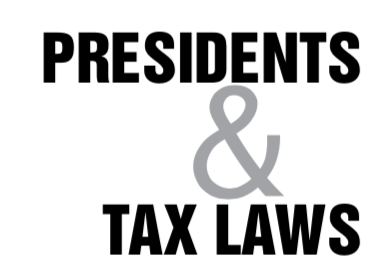Presidents & Tax Laws
Candidates running for president typically lay out their vision for America with lofty goals and plans to pursue these goals once elected. Following the election, often reality sets in as the new president deals with the constraints that come with governing. President-elect Biden is no different. During the campaign he often spoke of his plans to deal with multiple issues such as the pandemic, health care, the environment, racial equity and taxes. The following is an analysis of the Biden tax plan.
Numerous presidents have left their mark on taxes. During the last few decades Ronald Reagan is often cited as instituting the largest change in the tax law. Based upon “trickle down” economics, his 1981 Economic Recovery Act and 1986 Tax Reform Act provided sizable tax reductions aimed at restarting a recession-bound economy.
In more recent times George W. Bush made his mark in presidential tax history with tax reductions from the Economic Growth and Tax Relief Reconciliation Act in 2001 and the Jobs and Growth Tax Relief Reconciliation Act of 2003.
Barack Obama extended most of the Bush tax cuts in 2010 with the Tax Relief Unemployment Insurance Reauthorization and Job Creation Act. In 2012, most of the Bush Tax cuts were made permanent or extended with the American Tax Relief Act.
Donald Trump, in 2018, implemented the largest overhaul of the tax code in } decades with the Tax Cut and Jobs Act (TCJA).
The right tax plan can help you get elected. With the Biden tax plan, it is clear the president-elect will face strong crosswinds, if not head winds, from a potential Republican majority in the U.S. Senate. In addition, President-elect Biden will be operating in a tax environment that is socially and politically unsettled.
First, the tax environment is socially unsettled given the uncertainty surrounding possible extension of provisions of the Coronavirus Aid Relief and Economic Security Act (CARES Act).
WILL THE TCJA TAX CHANGES SURVIVE?
This 2020 law offered temporary tax relief to many affected by the Coronavirus. As of this article’s publication, provisions of this act, which expired in 2020, have not been extended, despite calls for additional relief.
Second, the tax environment is politically unsettled as the Trump tax law changes of 2018 (TCJA) have only been in place two years. Many of the TCJA tax provisions include a “sunset” provision, which effectively terminates them in 2025. However, in the meantime, a number of the TCJA provisions stand in stark contrast to Biden’s stated plans.
Central to the Biden tax plan is a campaign promise to not increase taxes to anyone earning less than $400,000 per year and a promise to increase taxes on corporations. Although not formally included in the official tax plan, Biden also stated he would repeal Trump tax cuts, although he did not specify which Trump
tax cuts were on the chopping block. Presumably the targeted provisions of the Tax Cut and Jobs Act (TCJA) are those that benefited individuals earning over $400,000 and corporations.
The following is a summary of key components of the TCJA that could go away or be limited under a Biden presidency.
INDIVIDUAL TAX CHANGES
Reduced Tax Rates
Prior to TCJA passage, the range of individual income tax rates spanned from 10% to 39.6% depending on a taxpayer’s level of taxable income and whether the taxpayer filed as single, married, or head of household. Beginning in 2018, for most taxpayers, tax rates spanned from 10% to 37%.
Standard Deductions and Personal Exemptions
In 2017, the last year prior to the TCJA, standard deductions ranged from $6,350 for single taxpayer to $12,700 for married taxpayers filing jointly. With the passage of TCJA, the 2018 standard deductions went to $12,000 for single and $24,000 for married filing jointly. These amounts are adjusted annually for inflation. In 2017, the personal exemption deduction for each qualifying dependent was $4,050. The TCJA eliminated the deduction for personal exemptions. The TCJA did increase the child tax credit from $500 to $2,000, providing tax relief in some cases due to the loss of personal exemptions.
Itemized Deductions
As a general rule, taxpayers deduct the larger of their standard deduction or their itemized deductions. Because the TCJA increased the standard deduction so markedly, beginning in 2018 most taxpayers took advantage of the standard deduction and did not deduct itemized deductions. To those who itemized, several changes were made to the determination of taxpayer itemized deductions. These include:
• Personal casualty and theft losses became only deductible for federally declared disasters.
• Miscellaneous itemized deductions were eliminated.
• The deduction for state and local tax is capped at $10,000 for married filing jointly and $5,000 for single filers.
• The deduction for home mortgage interest was tightened to exclude deduction of some home equity loan interest and interest on new mortgages in excess of $750,000 for married filing jointly taxpayers.
• The “Pease” limitation on itemized deductions was eliminated. The “Pease” limitation had the effect of reducing itemized deductions for upper income taxpayers.
The most recent changes to the Tax Code are those brought about by the 2020 CARES Act. These laws were passed in response to the coronavirus pandemic and are generally only applicable in 2020. Given the ongoing nature of the pandemic, an extension of these provisions or other provisions dealing with the pandemic economic fallout could be part of a Biden Tax Plan.NDIVIDUAL CARES ACT CHANGES
Tax Rebates
Tax rebates of up to $2,400 for married couples along with $500 per qualifying child were paid off in 2020 as part of the CARES Act. Not everyone received a rebate as rebates phased out for higher income taxpayers.
Retirement Fund Provisions
The requirement for many retirees to take the required distribution from their retirement plan was waived in
2020. If the distribution had already occurred, a rollover option was made available to some. In addition to this, some taxpayers were allowed to take up to a $100,000 retirement plan distribution. The distribution would be subject to income tax, but the taxable income would be spread over three years. The 10% early withdrawal penalty tax would not apply.
Charitable Contributions
In most years, charitable contributions are only deductible by taxpayers who itemize. In 2020, taxpayers who do not itemize may deduct up to $300 of charitable contributions to qualifying institutions.
BUSINESS CARES ACT CHANGES
Employee Retention Credits and Payroll Protection Program (PPP)
Qualifying employers affected by the coronavirus pandemic were entitled to an employment retention tax credit on a portion of the employers’ share of social security tax. Aside from this, the PPP authorized business loans with favorable terms for loan forgiveness. Corporate participants in the PPP were not eligible for the Employee Retention Credit.
Technical Modifications
The CARES Act also provided a number of technical changes, which temporarily provided tax relief to some corporations and business owners. These changes include:
The TCJA $500,000 limitation on deduction of business losses by owners was eliminated retroactively for years 2018-2020, allowing for larger deductible losses. The CARES Act also, for years 2020 and prior, made it easier for businesses to deduct net operating losses.
The TCJA 30% limit on the business interest deduction
Other Changes
The moving expense deduction was eliminated except for members of the Armed Forces who move pursuant to an order.
The exemption for estate and gift tax was doubled from $5 million to $10 million.
BUSINESS TAX LAW CHANGES
The corporate tax rate went from 35% to 21%.
The TCJA includes a limitation of deductibility of business interest expense for companies whose gross receipts averaged over $25 million per year.
The TCJA includes a limitation on taxpayers’ ability to deduct business losses. The initial limitation was set at the amount of the taxpayers’ business income plus $500,000.
The corporate alternative minimum tax was eliminated. Unlike other provisions of the TCJA, which sunset in 2025, the alternative minimum tax will not be back in 2025 absent Congressional action.
A deduction for 20% of qualified business income was passed for individuals and some small businesses.
President-elect Biden has published his tax plan and has spoken to other possible additional tax changes going forward. These changes include:
INDIVIDUAL TAX CHANGES
Social Security Tax
Currently employees pay, through paycheck withholding, 6.2% of their wages to Social Security on the first $137,400 of wages. Employers match this amount from their pockets when remitting the tax to the Social Security Administration. The Biden plan would continue this practice but also require employees (and presumably the self-employed) to also pay 6.2% on earnings above $400,000. Employers would be expected to match the additional 6.2% tax when remitting.
Tax Rates
The Biden tax plan proposes to increase the income tax rate for ordinary taxable income in excess
of $400,000 from 37% to 39.6%. Capital gains would be taxed at 39.6% under the Biden plan for taxpayers earning over $1 million as opposed to a top rate of 20% today.
Tax Credits
The Biden tax plan offers new or expanded tax credits in several areas. These include:
A tax credit to ensure no one pays more than
8.5% of their income on healthcare.
A tax credit targeted to helping pay for the
cost of the elderly.
Expanding the Childcare Credit to $8,000 per
year for low to middle income families.
A tax credit of up to $15,000 for first time
home buyers.
Retirement Benefits
The Biden tax plan will “equalize tax benefits” of retirement plans across upper income to low to middle income taxpayers.
BUSINESS TAX CHANGES
Domestic Taxes
The Biden tax plan would increase the corporate tax rate from 21% to 28%. The alternative minimum tax eliminated by the TCJA would be reinvented and brought back as a 15% tax on book income.
International Taxes
The Biden tax plan would include a 21% minimum tax on foreign earnings of U.S. companies located overseas. The plan will also include a penalty on companies that ship jobs overseas in order to sell products to America.
Other Possible Tax Changes
Although not specifically outlined in the Biden tax plan, estate taxes have been mentioned as a possible source of new tax revenue. Two specific tax changes have been mentioned.
Reduction in the current estate tax exemption. In 2020, the estates of those dying were exempt from federal estate tax if they were valued at less than $11.58 million. Biden has discussed the possibility of lowering this exemption dramatically in order to expand the tax base for the estate tax.
Elimination of the “stepped up basis.” Currently those who inherit assets are allowed to “step up” the “basis” of the assets to the fair market value at the date of death of the descendant (or six months later). Biden has discussed eliminating this “step up.” Why is this important?
Consider this example:
John’s grandfather invested $10,000 (the grandfather’s basis) in a business many years ago. The business is worth $1 million today. John’s grandfather dies and John inherits the business. Under current tax law, John would now have a $1 million basis in the business. If John sold the business for $1 million, he would pay no income tax because he sold it for his “basis”. If “stepped up” basis was eliminated, John would instead have a $10,000 basis in the business. A capital gains tax on the $990,000 increase in value would be due from John, presumably if he sold the business.Needless to say, there is a high level of uncertainty as to what income taxes will look like going forward. Not only do we have the confluence of the Biden plan, the CARES Act provisions, and the Trump tax cuts, but we also have possibility of either a Republican or Democrat controlled Senate.
The determination of which party controls the Senate could have a greater effect on tax policy than any of the just mentioned plans. With a Democrat-controlled Senate, we will likely see
laws closer to the Biden plan. With a Republican-controlled Senate, little may change until at least 2022.
JIM MARTIN, CPA, is a Henrietta and G.W. Snyder
Jr. Professor in Business/Sr. Lecturer at Washburn University School of Business.








